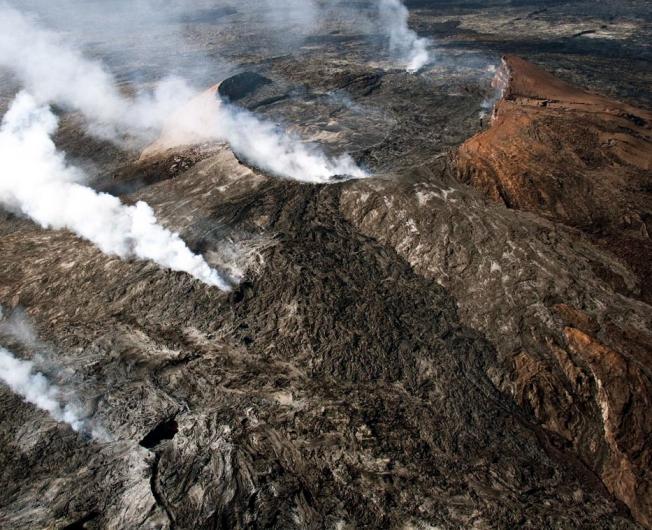Kilauea volcano scientists tracking lava flow edging toward subdivision’s last residence

Big Island scientists at Hawaiian Volcano Observatory are monitoring active pahoehoe (smooth lava flow) running downslope within the Royal Gardens subdivision and close to its last occupied residence.
Jack Thompson, who has lived in the subdivision for about three decades, has seen lava flows almost completely surround his “Lava House” B&B. In the past, Thompson’s home has always been spared. In an interview with Honolulu-based Hawaii News Now (TV news, KGMB and KHNL) that aired yesterday Thompson said: “After 30 years, you know, it’s not scary anymore.” Noting that the flow was within 500 yards of his home earlier this week, Thompson added, “It’s just entertainment.”
During 1983 — the year Puu Oo, a cinder cone Kilauea volcano’s eastern flanks (pictured, above), began erupting — lava flow destroyed houses and other buildings in Royal Gardens, which was then a largely undeveloped 1,800-acre community. The image (pictured, below) shows what remains of Royal Gardens. Thompson’s home is the in the upper third (center) of the green oval area.
Below is an observatory-issued summary highlighting recent volcanic activity tied to the ongoing 29-year Puu Oo eruption, among the longest-lasting Hawaiian eruptions in recorded history. The first written accounts of eruptions in Hawaii date back to the 1820s, when American missionaries arrived on the Big Island.

“The eruption in Kilauea’s middle east rift zone started with a fissure eruption on January 3, 1983, and has continued since at Puu Oo cone, or from vents within a few kilometers to the east or west, with few interruptions.” The summary continues: This year, “in early August, the Puu Oo crater floor collapsed to a depth of about 245 feet below the east rim of the crater as lava burst from vents on the lower west flank of the cone.” Lava reappeared in Puu Oo on Aug. 21 and filled the crater. On Sept. 21, “a fissure eruption on the upper southeast flank of Puu Oo drained lava lakes and fed a lava flow advancing in a southeast direction. Since then, activity has waxed and waned, with a lava tube feeding slow-moving pahoehoe flows to the southeast — into Royal Gardens, with some flows spreading to the coastal plain (within a few kilometers of the ocean).
Daily updates on Kilauea volcano activity are available at the Hawaiian Volcano Observatory website.
HawaiiMagazine.com has reported regularly on lava activity at Kilauea volcano and Hawaii Volcanoes National Park on the Big Island. Click here to catch up with all of our Volcano News posts. You can also follow our updates on our Twitter and Facebook pages.


